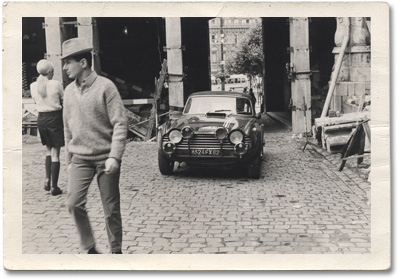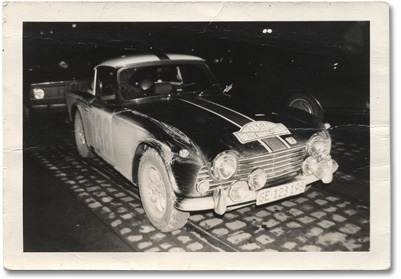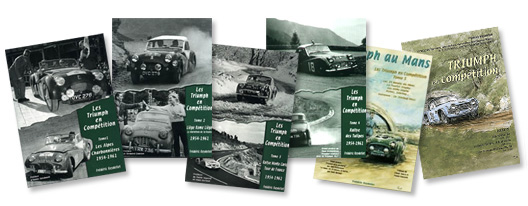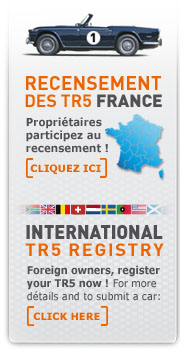The Triumph TR5 had a very brief racing career towards the end of the sixties that was totally in keeping with its limited production run. This is perhaps one of the reasons why the car is so much sought after today.
When the new TR5 was launched in autumn of 1967, the Triumph competitions department was a pale shadow of the organisation that had seen the light of day in 1954. It had been set up under the responsibility of Ken Richardson when the TR2 came out, and it entered almost all the models of the make from the humble Standard to the Herald in different categories to emphasize the sporting character of the British company.
After the first TRs came the years of the TR4 and the Spitfire between 1962 and 1965. In the hands of works drivers and amateurs they won several rallies and races, and Triumph came back to Le Mans in 1964 and 1965 with the agile and rapid Spitfires.
In 1966, the future of Triumph looked very bleak as it was linked to that of British Leyland, and the make became jumbled up in Abingdon’s competitions programme that already included Austin Healey, BMC and MG. In fact, when the TR5 appeared on the market there was no question of a competitions programme. Not until later would the name Triumph appear on the podiums because of the performance of the 2.5 litre Pi saloons, Dolomites and the TR7.
The car’s situation was not helped either by the fact that from 1966 onwards, the new Appendix J of the International Sporting Code did not give any advantage to so-called GT cars, but favoured the development of very fast touring cars. This led to the birth of myths like the Mini Cooper, the Lotus Cortina, the Porsche 911 and the Alpine Berlinette among others.
But despite all the political and financial intrigues surrounding its creation, the TR5 raced thanks to the determination of some talented privateers. The story of two of them highlights some of the best achievements of the TR5’s short racing career.
When the new TR5 was launched in autumn of 1967, the Triumph competitions department was a pale shadow of the organisation that had seen the light of day in 1954. It had been set up under the responsibility of Ken Richardson when the TR2 came out, and it entered almost all the models of the make from the humble Standard to the Herald in different categories to emphasize the sporting character of the British company.
After the first TRs came the years of the TR4 and the Spitfire between 1962 and 1965. In the hands of works drivers and amateurs they won several rallies and races, and Triumph came back to Le Mans in 1964 and 1965 with the agile and rapid Spitfires.
In 1966, the future of Triumph looked very bleak as it was linked to that of British Leyland, and the make became jumbled up in Abingdon’s competitions programme that already included Austin Healey, BMC and MG. In fact, when the TR5 appeared on the market there was no question of a competitions programme. Not until later would the name Triumph appear on the podiums because of the performance of the 2.5 litre Pi saloons, Dolomites and the TR7.
The car’s situation was not helped either by the fact that from 1966 onwards, the new Appendix J of the International Sporting Code did not give any advantage to so-called GT cars, but favoured the development of very fast touring cars. This led to the birth of myths like the Mini Cooper, the Lotus Cortina, the Porsche 911 and the Alpine Berlinette among others.
But despite all the political and financial intrigues surrounding its creation, the TR5 raced thanks to the determination of some talented privateers. The story of two of them highlights some of the best achievements of the TR5’s short racing career.

Frenchman Roger Barbara was interested in Triumphs as a kid although he began racing on motorbikes. “I was born in Aire on the Lys (a river) in the twenties, after my father of Spanish origin was demobbed there ” Roger explains today. “That’s where he put down his roots and I spent all my life in the family house. My father built bikes and then became interested in motorbikes and cars, so the ground was well prepared for me! In 1946, I got my first motorbike, a Norton, but because money was scarce I turned to motocross. That’s where I rode my first Triumphs, a make that I’d literally idolised since the war as I’d seen British soldiers riding some fantastic machines. I raced bikes for a number of years, and when I decided to start car racing I naturally chose Triumphs. This was in 1962. The TR3 was at the end of the road and the TR4 had just been launched. I read a classified ad, made a phone call and I started rallying in my first TR4.”
In the meantime Roger opened his garage in Aire-sur-Lys and became a Triumph agent. Soon he was one of the make’s biggest dealers in France. “When the Spitfire arrived, I sold one a day in summer,” he recalls.
When he began racing, the cars he drove followed the evolution of the new models. He raced the TR4, the Spitfire and the Triumph 2000 saloon racking up good results in the north of France and in some of the major international events. He was one of the few French drivers to compete in rallies with the Triumph. In 1967, he finally got his hands on a TR5.
“I prepared my TR5 for the 1968 Portuguese Rally. It was a long, very tiring event as the concentration run brought us from Paris to Portugal before the rally really began. The roads were mainly gravel and there was a lot of navigation. I raced in Portugal twice with my TR5 in 1968 and 1969. Both times we were eliminated for checking in too late. Fatigue played havoc with my co-drivers, and I still suspect them of having been a bit too generous with the seconds in their calculations! In 1969, we were on the pace. That year, as a result of a navigational error we found ourselves behind Tony Fall in a works Lancia. We were glued to his rear bumper and I kept my foot to the floorboards. He couldn’t shake me off and as for my co-driver, he was speechless! That kind of state of grace happens from time to time when you’re a driver. You had to be crazy? No, not really. We were just completely caught up in the heat of the action.
I then did some more rallies in the north of France with the TR5. It was a really good powerful car, and had the defects that were part of the charm of the TR4. In 1968, I raced in the famous Road Marathon on the redoubtable Nürburgring in the Eifel Mountains with my team-mates Amaury Duvauchel and Roger Mordacq. It lasted for eight-four hours on this incredible track, and the TR5 was still there eighteen laps from the finish when a front hub carrier broke. We were thirty-fifth and very disappointed that we had to retire: it was a great rehearsal for the following year when I came back with my TR6.”
And 1969 was a big success, 3rd overall, 1st in category and 1st in the regularity classification taking into account the time spent in the pits. Bravo Roger!
In the meantime Roger opened his garage in Aire-sur-Lys and became a Triumph agent. Soon he was one of the make’s biggest dealers in France. “When the Spitfire arrived, I sold one a day in summer,” he recalls.
When he began racing, the cars he drove followed the evolution of the new models. He raced the TR4, the Spitfire and the Triumph 2000 saloon racking up good results in the north of France and in some of the major international events. He was one of the few French drivers to compete in rallies with the Triumph. In 1967, he finally got his hands on a TR5.
“I prepared my TR5 for the 1968 Portuguese Rally. It was a long, very tiring event as the concentration run brought us from Paris to Portugal before the rally really began. The roads were mainly gravel and there was a lot of navigation. I raced in Portugal twice with my TR5 in 1968 and 1969. Both times we were eliminated for checking in too late. Fatigue played havoc with my co-drivers, and I still suspect them of having been a bit too generous with the seconds in their calculations! In 1969, we were on the pace. That year, as a result of a navigational error we found ourselves behind Tony Fall in a works Lancia. We were glued to his rear bumper and I kept my foot to the floorboards. He couldn’t shake me off and as for my co-driver, he was speechless! That kind of state of grace happens from time to time when you’re a driver. You had to be crazy? No, not really. We were just completely caught up in the heat of the action.
I then did some more rallies in the north of France with the TR5. It was a really good powerful car, and had the defects that were part of the charm of the TR4. In 1968, I raced in the famous Road Marathon on the redoubtable Nürburgring in the Eifel Mountains with my team-mates Amaury Duvauchel and Roger Mordacq. It lasted for eight-four hours on this incredible track, and the TR5 was still there eighteen laps from the finish when a front hub carrier broke. We were thirty-fifth and very disappointed that we had to retire: it was a great rehearsal for the following year when I came back with my TR6.”
And 1969 was a big success, 3rd overall, 1st in category and 1st in the regularity classification taking into account the time spent in the pits. Bravo Roger!

1968 was also the year that Swiss driver Jean-Jacques Thuner raced the TR5. He had just finished four years in the Triumph Competitions department, which he joined in 1962 to rally the TR4. “I began in the fifties with a TR3 in which I won the Geneva Rally. Ken Richardson gave me a works TR3 for the Monte Carlo, but there wasn’t much future as Triumph shut down its competitions department in 1961. It started up again a year later. Triumph signed me to drive a TR4 and I became a fully-fledged works driver with my old mate John Gretener. We were part of the team until 1966 driving TR4s, Spitfires and the fantastic 2000 saloons with their 6-cylinder engines. Since my debut I always had the backup of Pierre Blanc, the make’s Swiss importer, and when I had to quit Triumph I turned to him. We bought one of the old Le Mans Spitfires in which I did a lot of hill climbing and circuit races, and we also developed a small programme based around the TR5.”
Jean-Jacques drove a TR5 in the Monte Carlo Rally on what was also his first outing in the European Rally Championship. It was an exciting experience. “We’d developed a very good car as the 6-cylinde engine was really magic. It was prepared and fine-tuned in England because we still had our contacts there. The car was very quick putting out around 185 bhp. In the in the Vercors in the middle of the night, the magnesium arm on which the rear suspension was mounted, broke, parted company with the car together with the rear wheel, drive shaft and brake drum. At the speed we were going on the Rousset road in darkness, it was a pretty hairy experience! I also drove the TR5 in hill climbs and then in the Geneva Rally, which we almost won, as we lost by around five to ten seconds. I’m sure that the TR5 was as good as a Porsche at the time and in hill climbs it was unbeatable. Its only defect was its braking in downhill conditions where the Porsche was better. Geneva was my last event with John as it was time to take stock of things. But what fantastic memories!”
Jean-Jacques drove a TR5 in the Monte Carlo Rally on what was also his first outing in the European Rally Championship. It was an exciting experience. “We’d developed a very good car as the 6-cylinde engine was really magic. It was prepared and fine-tuned in England because we still had our contacts there. The car was very quick putting out around 185 bhp. In the in the Vercors in the middle of the night, the magnesium arm on which the rear suspension was mounted, broke, parted company with the car together with the rear wheel, drive shaft and brake drum. At the speed we were going on the Rousset road in darkness, it was a pretty hairy experience! I also drove the TR5 in hill climbs and then in the Geneva Rally, which we almost won, as we lost by around five to ten seconds. I’m sure that the TR5 was as good as a Porsche at the time and in hill climbs it was unbeatable. Its only defect was its braking in downhill conditions where the Porsche was better. Geneva was my last event with John as it was time to take stock of things. But what fantastic memories!”
To sum up it’s worth remembering that a Swiss TR5 won the professionals category Monte Carlo driven by Werner Lier with Maurice Gatsonides as navigator; he had been a works driver for Triumph between 1954 and 1960 having competed in the rally 23 times between 1936 and 1970!
Frédéric Reydellet
Frédéric Reydellet
I’d like to express our thanks to Frédéric for his brief summary of the TR5’s racing history. Don’t miss the 6 volumes of his thrilling collection,
“Les Triumphs en Competition,” which is available from all good bookshops or from the author. Contact him to place your order. Click here.










